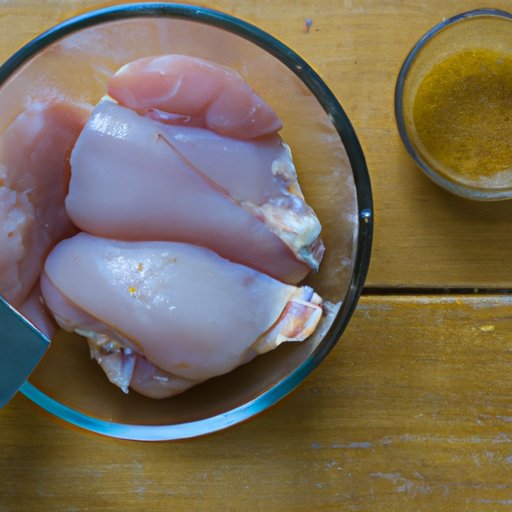
I. Introduction
When it comes to cooking chicken, there are many misconceptions about how much it weighs before and after cooking. It’s important to know the weight loss during cooking to understand how much chicken you need to buy to end up with your desired amount. This is especially essential for people who are on a tight budget or dietary restrictions. In this article, we explore the concept of weight loss during cooking and provide helpful tips on how to ensure your chicken doesn’t turn out dry or overcooked.
II. Understanding the Weight Loss of Chicken
One of the main reasons chicken loses weight during cooking is due to water loss. According to USDA research, chicken can lose around 20-30% of its weight during cooking on average. This rate can vary depending on the type of cut and cooking method used.
Here are the weight loss percentage for some of the most common chicken cuts:
- Breast: 20-30%
- Thigh: 18-25%
- Wings: 10-15%
- Drumsticks: 15-20%
To avoid drying out your chicken during cooking, you can use a meat thermometer to check the internal temperature and ensure that it has reached the safe minimum temperature recommended by the USDA (165°F / 74°C).
III. Cooking Chicken to Perfection
The time and temperature required to cook chicken properly depend on the cut and the cooking method used. Here are some general guidelines:
- Breast: 20-30 minutes at 350-375°F (180-190°C)
- Thigh: 25-35 minutes at 350-375°F (180-190°C)
- Wings: 20-25 minutes at 375-400°F (190-205°C)
- Drumsticks: 30-40 minutes at 350-375°F (180-190°C)
The internal temperature should be measured with a meat thermometer and it should read 165°F (74°C) for all cuts. To get an accurate measurement of the pre-cooked and post-cooked weight of chicken, use a kitchen scale.
The cooking style can also affect the weight loss of chicken. For example, slow cooker recipes might lead to less weight loss compared to oven-baked chicken, where the high temperature can quickly cook your chicken and force out more moisture.
IV. The Impact of Seasoning and Marinades
Seasonings and marinades can enhance the flavor and texture of your chicken, but they can also add to the weight loss during cooking. Some seasoning and marinades can remove moisture from the chicken, while others can help retain moisture.
Here are some tips:
- Avoid using too much salt, as it can draw out moisture from the chicken
- Consider marinating the chicken before cooking, which involves soaking the chicken in a mixture of oil, vinegar, or other acidic ingredients that can help tenderize the chicken and retain moisture
- Use a cooking bag or aluminum foil to trap the moisture and infuse the chicken with the seasoning or marinade flavors
V. Conclusion
To achieve the perfect meal, it’s essential to understand the weight loss of chicken during cooking. The weight loss percentage varies based on the cut, cooking time, temperature, and seasoning used. By using a kitchen scale, a meat thermometer and implementing some of the tips provided in this article, you can cook perfect chicken every time.
We hope this article has helped you understand the weight loss of chicken during cooking and provided helpful tips on how to cook chicken to perfection. Share your tips and experiences with us in the comments below.




